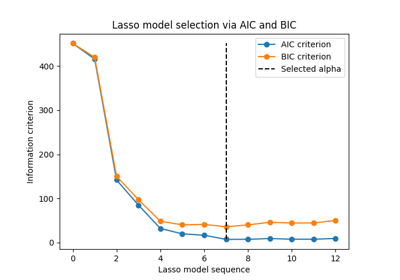LassoLarsIC#
- class sklearn.linear_model.LassoLarsIC(criterion='aic', *, fit_intercept=True, verbose=False, precompute='auto', max_iter=500, eps=np.float64(2.220446049250313e-16), copy_X=True, positive=False, noise_variance=None)#
Lasso模型使用Lars并通过BIC或AIC进行模型选择。
Lasso的优化目标为:
(1 / (2 * n_samples)) * ||y - Xw||^2_2 + alpha * ||w||_1
AIC是Akaike信息准则[Rde9cc43d0d41-2]_,BIC是Bayes信息准则[Rde9cc43d0d41-3]_。这些准则通过在拟合优度和模型复杂度之间进行权衡,有助于选择正则化参数的值。一个好的模型应该很好地解释数据,同时保持简单。
更多信息请参阅 用户指南 。
- Parameters:
- criterion{‘aic’, ‘bic’}, default=’aic’
使用的准则类型。
- fit_interceptbool, default=True
是否计算此模型的截距。如果设置为false,则在计算中不使用截距(即数据应已中心化)。
- verbosebool or int, default=False
设置详细程度。
- precomputebool, ‘auto’ or array-like, default=’auto’
是否使用预计算的Gram矩阵以加速计算。如果设置为
'auto',则由我们决定。Gram矩阵也可以作为参数传递。- max_iterint, default=500
执行的最大迭代次数。可用于提前停止。
- epsfloat, default=np.finfo(float).eps
在计算Cholesky对角因子时使用的机器精度正则化。对于非常病态的系统,增加此值。与某些基于迭代优化的算法中的
tol参数不同,此参数不控制优化的容差。- copy_Xbool, default=True
如果为True,将复制X;否则,可能会覆盖X。
- positivebool, default=False
限制系数为>= 0。请注意,您可能希望删除默认设置为True的fit_intercept。在正限制下,模型系数不会收敛到普通最小二乘解,对于alpha的小值。只有通过逐步Lars-Lasso算法达到的最小alpha值(
alphas_[alphas_ > 0.].min()当fit_path=True时)的系数通常与坐标下降Lasso估计器的解一致。因此,使用LassoLarsIC仅对预期和/或达到稀疏解的问题有意义。- noise_variancefloat, default=None
数据的估计噪声方差。如果为
None,则通过OLS模型计算无偏估计。然而,只有在n_samples > n_features + fit_intercept的情况下才可能。Added in version 1.1.
- Attributes:
- coef_array-like of shape (n_features,)
参数向量(公式中的w)
- intercept_float
决策函数中的独立项。
- alpha_float
由信息准则选择的alpha参数
- alphas_array-like of shape (n_alphas + 1,) or list of such arrays
每次迭代时的最大协方差(绝对值)。
n_alphas要么是max_iter,n_features,要么是路径中alpha >= alpha_min的节点数,以较小者为准。如果是列表,则长度为n_targets。- n_iter_int
由lars_path运行以找到alpha网格的迭代次数。
- criterion_array-like of shape (n_alphas,)
所有alpha的信息准则(’aic’,’bic’)值。选择具有最小信息准则的alpha,如[Rde9cc43d0d41-1]_中所述。
- noise_variance_float
用于计算准则的数据的估计噪声方差。
Added in version 1.1.
- n_features_in_int
fit 期间看到的特征数。
Added in version 0.24.
- feature_names_in_ndarray of shape (
n_features_in_,) fit 期间看到的特征名称。仅当
X的特征名称均为字符串时定义。Added in version 1.0.
See also
lars_path使用LARS算法计算最小角回归或Lasso路径。
lasso_path使用坐标下降计算Lasso路径。
Lasso使用L1先验作为正则化训练的线性模型(又名Lasso)。
LassoCV沿正则化路径迭代拟合的Lasso线性模型。
LassoLars使用最小角回归(又名Lars)拟合的Lasso模型。
LassoLarsCV使用LARS算法的交叉验证Lasso。
sklearn.decomposition.sparse_encode稀疏编码。
Notes
自由度的数量按[Rde9cc43d0d41-1]_中的方法计算。
有关AIC和BIC准则的数学公式的更多详细信息,请参阅 用户指南 。
References
Examples
>>> from sklearn import linear_model >>> reg = linear_model.LassoLarsIC(criterion='bic') >>> X = [[-2, 2], [-1, 1], [0, 0], [1, 1], [2, 2]] >>> y = [-2.2222, -1.1111, 0, -1.1111, -2.2222] >>> reg.fit(X, y) LassoLarsIC(criterion='bic') >>> print(reg.coef_) [ 0. -1.11...]
- fit(X, y, copy_X=None)#
拟合模型使用 X, y 作为训练数据。
- Parameters:
- X形状为 (n_samples, n_features) 的类数组
训练数据。
- y形状为 (n_samples,) 的类数组
目标值。如有必要,将被转换为 X 的数据类型。
- copy_Xbool, 默认=None
如果提供,此参数将覆盖在实例创建时所做的 copy_X 选择。 如果
True,X 将被复制;否则,它可能会被覆盖。
- Returns:
- selfobject
返回 self 的一个实例。
- get_metadata_routing()#
获取此对象的元数据路由。
请查看 用户指南 以了解路由机制的工作原理。
- Returns:
- routingMetadataRequest
MetadataRequest封装的 路由信息。
- get_params(deep=True)#
获取此估计器的参数。
- Parameters:
- deepbool, 默认=True
如果为True,将返回此估计器和包含的子对象(也是估计器)的参数。
- Returns:
- paramsdict
参数名称映射到它们的值。
- predict(X)#
使用线性模型进行预测。
- Parameters:
- Xarray-like 或 sparse matrix, shape (n_samples, n_features)
样本。
- Returns:
- Carray, shape (n_samples,)
返回预测值。
- score(X, y, sample_weight=None)#
返回预测的决定系数。
决定系数 \(R^2\) 定义为 \((1 - rac{u}{v})\) ,其中 \(u\) 是残差平方和
((y_true - y_pred)** 2).sum(),而 \(v\) 是总平方和((y_true - y_true.mean()) ** 2).sum()。最好的可能得分是 1.0,它可能是负的(因为模型可能任意地差)。一个总是预测y的期望值的常数模型,忽略输入特征,将得到 \(R^2\) 得分为 0.0。- Parameters:
- Xarray-like of shape (n_samples, n_features)
测试样本。对于某些估计器,这可能是一个预计算的核矩阵或一个形状为
(n_samples, n_samples_fitted)的通用对象列表,其中n_samples_fitted是估计器拟合中使用的样本数量。- yarray-like of shape (n_samples,) or (n_samples, n_outputs)
X的真实值。- sample_weightarray-like of shape (n_samples,), default=None
样本权重。
- Returns:
- scorefloat
\(R^2\) 相对于
y的self.predict(X)。
Notes
在调用回归器的
score时使用的 \(R^2\) 得分从 0.23 版本开始使用multioutput='uniform_average'以保持与r2_score默认值一致。 这影响了所有多输出回归器的score方法(除了MultiOutputRegressor)。
- set_fit_request(*, copy_X: bool | None | str = '$UNCHANGED$') LassoLarsIC#
Request metadata passed to the
fitmethod.Note that this method is only relevant if
enable_metadata_routing=True(seesklearn.set_config). Please see User Guide on how the routing mechanism works.The options for each parameter are:
True: metadata is requested, and passed tofitif provided. The request is ignored if metadata is not provided.False: metadata is not requested and the meta-estimator will not pass it tofit.None: metadata is not requested, and the meta-estimator will raise an error if the user provides it.str: metadata should be passed to the meta-estimator with this given alias instead of the original name.
The default (
sklearn.utils.metadata_routing.UNCHANGED) retains the existing request. This allows you to change the request for some parameters and not others.Added in version 1.3.
Note
This method is only relevant if this estimator is used as a sub-estimator of a meta-estimator, e.g. used inside a
Pipeline. Otherwise it has no effect.- Parameters:
- copy_Xstr, True, False, or None, default=sklearn.utils.metadata_routing.UNCHANGED
Metadata routing for
copy_Xparameter infit.
- Returns:
- selfobject
The updated object.
- set_params(**params)#
设置此估计器的参数。
该方法适用于简单估计器以及嵌套对象(例如
Pipeline)。后者具有形式为<component>__<parameter>的参数,以便可以更新嵌套对象的每个组件。- Parameters:
- **paramsdict
估计器参数。
- Returns:
- selfestimator instance
估计器实例。
- set_score_request(*, sample_weight: bool | None | str = '$UNCHANGED$') LassoLarsIC#
Request metadata passed to the
scoremethod.Note that this method is only relevant if
enable_metadata_routing=True(seesklearn.set_config). Please see User Guide on how the routing mechanism works.The options for each parameter are:
True: metadata is requested, and passed toscoreif provided. The request is ignored if metadata is not provided.False: metadata is not requested and the meta-estimator will not pass it toscore.None: metadata is not requested, and the meta-estimator will raise an error if the user provides it.str: metadata should be passed to the meta-estimator with this given alias instead of the original name.
The default (
sklearn.utils.metadata_routing.UNCHANGED) retains the existing request. This allows you to change the request for some parameters and not others.Added in version 1.3.
Note
This method is only relevant if this estimator is used as a sub-estimator of a meta-estimator, e.g. used inside a
Pipeline. Otherwise it has no effect.- Parameters:
- sample_weightstr, True, False, or None, default=sklearn.utils.metadata_routing.UNCHANGED
Metadata routing for
sample_weightparameter inscore.
- Returns:
- selfobject
The updated object.



